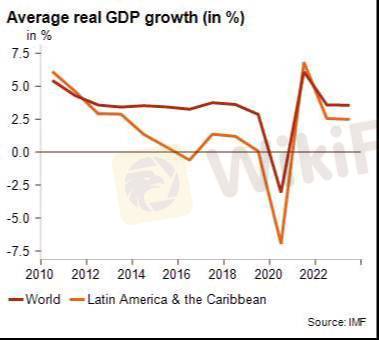
2024-12-31 05:00
IndustryLATIN AMERICAN COMMODITY MARKET
#Wherearethepost-holidayrallyopportunities?Michriches#
As the post-holiday period unfolds, Latin American commodity markets are experiencing notable developments across various sectors:
Energy Commodities
Oil and Gas: Brazil has significantly increased its imports of Russian diesel, receiving 10.8 million barrels in December 2024. This shift indicates a diversification of energy sources and a response to global market dynamics.
Agricultural Commodities
Coffee: Arabica coffee prices have reached new all-time highs, driven by concerns over Brazil's upcoming crop. A severe drought in 2024 stressed coffee trees, raising apprehensions about the 2025 harvest. Although October rains facilitated flowering, there are lingering doubts about the trees' capacity to produce a substantial yield.
Soybeans: Chicago soybean futures have declined to four-year lows, attributed to expectations of a large Brazilian harvest. In 2024, soybean prices dropped by 26%, reflecting increased global output without a corresponding rise in consumption.
Metals and Mining
Aluminum: Argentina's largest aluminum producer, Aluar, successfully raised USD $30 million through bond sales, indicating renewed confidence in the local financing markets for industrial manufacturers.
Currency and Trade Dynamics
Currency Strength: Latin American currencies have strengthened in response to surges in commodity prices and shifts in monetary policies. For instance, the Chilean peso rose by 0.57%, buoyed by these factors.
Trade Policies: The region remains attentive to potential impacts from U.S. trade policies, especially in light of the upcoming U.S. elections. Changes in tariffs and trade agreements could significantly influence Latin American commodity markets.
Market Outlook
Analysts project that global commodity prices are set to decline to a five-year low in 2025, amid an anticipated oil glut. Despite this, overall commodity prices are expected to remain 30% higher than pre-pandemic levels, indicating sustained demand and market resilience.
In summary, the post-holiday period presents a complex landscape for Latin American commodity markets, influenced by climatic challenges, currency fluctuations, and evolving global trade policies. Stakeholders should closely monitor these factors to navigate the market effectively.
Like 0
Kenny 6816
Trader
Hot content
Industry
Event-A comment a day,Keep rewards worthy up to$27
Industry
Nigeria Event Giveaway-Win₦5000 Mobilephone Credit
Industry
Nigeria Event Giveaway-Win ₦2500 MobilePhoneCredit
Industry
South Africa Event-Come&Win 240ZAR Phone Credit
Industry
Nigeria Event-Discuss Forex&Win2500NGN PhoneCredit
Industry
[Nigeria Event]Discuss&win 2500 Naira Phone Credit
Forum category

Platform

Exhibition

Agent

Recruitment

EA

Industry

Market

Index
LATIN AMERICAN COMMODITY MARKET
 Nigeria | 2024-12-31 05:00
Nigeria | 2024-12-31 05:00#Wherearethepost-holidayrallyopportunities?Michriches#
As the post-holiday period unfolds, Latin American commodity markets are experiencing notable developments across various sectors:
Energy Commodities
Oil and Gas: Brazil has significantly increased its imports of Russian diesel, receiving 10.8 million barrels in December 2024. This shift indicates a diversification of energy sources and a response to global market dynamics.
Agricultural Commodities
Coffee: Arabica coffee prices have reached new all-time highs, driven by concerns over Brazil's upcoming crop. A severe drought in 2024 stressed coffee trees, raising apprehensions about the 2025 harvest. Although October rains facilitated flowering, there are lingering doubts about the trees' capacity to produce a substantial yield.
Soybeans: Chicago soybean futures have declined to four-year lows, attributed to expectations of a large Brazilian harvest. In 2024, soybean prices dropped by 26%, reflecting increased global output without a corresponding rise in consumption.
Metals and Mining
Aluminum: Argentina's largest aluminum producer, Aluar, successfully raised USD $30 million through bond sales, indicating renewed confidence in the local financing markets for industrial manufacturers.
Currency and Trade Dynamics
Currency Strength: Latin American currencies have strengthened in response to surges in commodity prices and shifts in monetary policies. For instance, the Chilean peso rose by 0.57%, buoyed by these factors.
Trade Policies: The region remains attentive to potential impacts from U.S. trade policies, especially in light of the upcoming U.S. elections. Changes in tariffs and trade agreements could significantly influence Latin American commodity markets.
Market Outlook
Analysts project that global commodity prices are set to decline to a five-year low in 2025, amid an anticipated oil glut. Despite this, overall commodity prices are expected to remain 30% higher than pre-pandemic levels, indicating sustained demand and market resilience.
In summary, the post-holiday period presents a complex landscape for Latin American commodity markets, influenced by climatic challenges, currency fluctuations, and evolving global trade policies. Stakeholders should closely monitor these factors to navigate the market effectively.
Like 0
I want to comment, too
Submit
0Comments

There is no comment yet. Make the first one.

Submit
There is no comment yet. Make the first one.